Discover my beautiful countries
Glücksburg
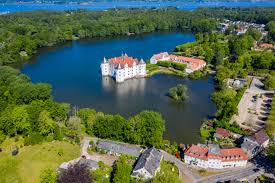
Glücksburg ist die nördlichste Stadt Deutschlands, mit der Fähre nur etwa eine Stunde von Dänemark entfernt, Luftlinie sogar nur ca. drei Kilometer. Es liegt an der Flensburger Förde, einem westlichen Meeresarm der Ostsee.
Glücksburg is the most northerly town in Germany, only about an hour from Denmark by ferry, as the crow flies only about three kilometres. It lies on the Flensburg Fjord, a western arm of the Baltic Sea.
Es ist daher kein Wunder, dass es in Glücksburg auch eine bedeutende dänische Minderheit gibt. Sogar einen dänischen Kindergarten, eine dänische Schule und eine dänische Kirche findet man dort, und seit 2016 ist sogar das Ortsschild zweisprachig: Glücksburg – Lyksborg.
It is therefore no wonder that there is also a significant Danish minority in Glücksburg. You can even find a Danish kindergarten, a Danish school and a Danish church there, and since 2016 even the town sign is bilingual: Glücksburg – Lyksborg.
Die Stadt ist ziemlich klein. Sie hat nur wenig mehr als 6000 Einwohner, aber sie ist ein Anziehungspunkt für Touristen. Deshalb gibt es dort auch viele Hotels, Pensionen und Ferienwohnungen.
The town is quite small. It has only a little more than 6000 inhabitants, but it is an attraction for tourists. That is why there are many hotels, guesthouses and holiday flats there.

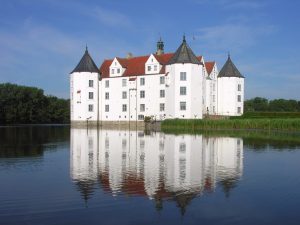
Die bekannteste Sehenswürdigkeit ist das Wasserschloss. Es wurde im 16. Jahrhundert auf den Ruinen eines alten Klosters gebaut. Dann wurde der Rest des Klostergeländes geflutet. Das ist der heutige See, der das Schloss umgibt.
The best-known sight is the moated castle. It was built in the 16th century on the ruins of an old monastery. Then the rest of the monastery grounds were flooded. This is the lake that surrounds the castle today.
In der Orangerie des Schlosses finden heute oft Ausstellungen und Konzerte statt, und das Rosarium, das in einem Teil des alten Schlossparks 1991 eröffnet wurde, beherbergt ca. 500 Rosensorten und ist ein Augen- und Nasenschmaus.
Today, exhibitions and concerts are often held in the castle’s orangery, and the Rosarium, which opened in a section of the old castle park in 1991, features around 500 varieties of roses and is a feast for eyes and noses.
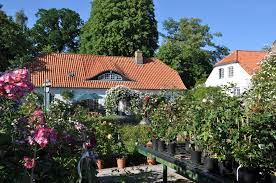

Der andere Grund für die Beliebtheit des kleinen Ortes ist seine Nähe zum Meer. Der Stadtteil Sandwig ist schon seit dem 19. Jahrhundert ein beliebtes Ostseebad, und südlich davon gibt es auch relative einsame Naturstrände. Aber auch die größte und älteste Yachtschule Deutschlands befindet sich nicht weit von hier.
The other reason for the small town’s popularity is its proximity to the sea. The Sandwig district has been a popular seaside resort since the 19th century, and to the south, there are also relatively secluded natural beaches. And Germany’s largest and oldest yachting school is also not far from here.
Außerdem ist Glücksburg von einem der größten Waldgebiete des Bundeslandes Schleswig-Holstein umgeben. Südlich der Stadt gibt es sogar einen 20 Hektar großen „Hundewald“, der speziell für unsere vierbeinigen Freunde und ihre menschlichen Begleiter gedacht ist.
Glücksburg is also surrounded by one of the largest forest areas in the state of Schleswig-Holstein. South of the town there is even a 20-hectare “dog forest” especially for our four-legged friends and their human companions.
https://de.wikipedia.org/wiki/Gl%C3%BCcksburg_(Ostsee)
https://www.spottinghistory.com/view/4537/glucksburg-castle/
https://www.gluecksburg-urlaub.de/urlaub/urlaub-mit-hund/
Bray-Dunes
Voici la commune la plus septentrionale de la France. C’est une petite ville de 4500 habitants qui consiste en une grande partie de résidences secondaires. Elle se trouve dans le département du Nord à proximité de la métropole de Dunkerque à l’ouest et de la frontière avec la Belgique à l’est au bord de la Mer du Nord.
This is the northernmost commune in France. It is a small town of 4,500 inhabitants, most of which consists of second homes. It is located in the Nord department, close to the metropolis of Dunkerque to the west and the border with Belgium to the east, on the North Sea.
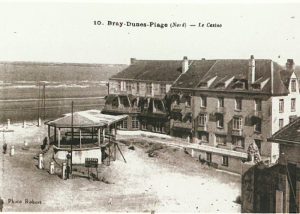
Le nom de Bray-Dunes provient du nom d’Alphonse Bray, un armateur de Dunkerque qui achète un grand terrain de dunes en 1870 et y fait construire une maison de retraite pour les vieux marins de commerce et les infirmes de la marine. Dans cette « maison hospitalière », il établit aussi une petite école pour les enfants des habitants du hameau de pêcheurs voisin. Alphonse Bray fait aussi construire une église, Notre-Dame des Dunes.
The name Bray-Dunes comes from the name of Alphonse Bray, a shipowner from Dunkirk, who bought a large piece of land in the dunes in 1870 and built a retirement home for old merchant seamen and the infirm. In this “hospital house” he also established a small school for the children of the inhabitants of the neighbouring fishermen’s hamlet. Alphonse Bray also built a church, Notre-Dame des Dunes.
A la fin du XIXème Siècle, les vacances à la plage deviennent très à la mode, et les personnes aisées des grandes villes comme Lille viennent à Bray-Dunes pour s’y détendre et rencontrer les gens de la « jet-set » de l’époque. Plusieurs hôtels et un grand nombre de villas sont construits pendant les prochains 50 ans.
At the end of the 19th century, beach holidays became very fashionable, and wealthy people from big cities like Lille came to Bray-Dunes to relax and meet the “jet-set” of the time. Several hotels and a large number of villas were built during the next 50 years.
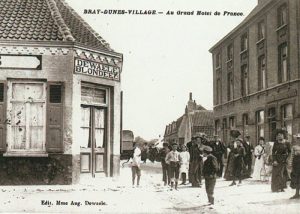
Pendant la Seconde Guerre Mondiale, la ville se trouve « au cœur du théâtre des opérations militaires ». Les habitants participent à l’évacuation des troupes alliées, et plus tard, font partie de la zone occupée. La ville est détruite en grande partie, et la reconstruction après la fin de la guerre est lente.
During the Second World War, the town was “in the heart of the theatre of military operations”. The inhabitants took part in the evacuation of the Allied troops, and later became part of the occupied zone. The city was largely destroyed and reconstruction after the end of the war was slow.
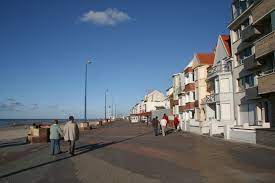
En 1953, un raz de marée cause des dommages considérables. Mais la population augmente néanmoins pendant les décennies qui suivent, et le tourisme devient l’activité économique la plus importante de la ville.
In 1953, a tidal wave caused considerable damage. However, the population grew in the following decades and tourism became the most important economic activity in the city.
La Dune du Perroquet, l’endroit où se situait l’ancien poste de frontière, offre maintenant de nombreuses randonnées ainsi que des actions pour une éducation à l’environnement.
The Dune du Perroquet, the place where the former border post was located, now offers many walks as well as actions for environmental education.
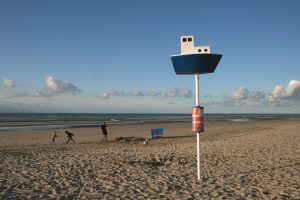
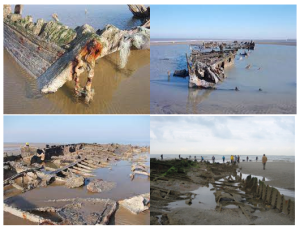
A marée basse, on peut voir des épaves de plusieurs bateaux dont la plupart datent de la Seconde Guerre mondiale.
At low tide, you can see the wrecks of several ships, most of which date from the Second World War.
De nombreux bunkers, décorés de graffiti, se trouvent toujours sur la plage et sont maintenant des attractions touristiques.
Many bunkers, decorated with graffiti, still stand on the beach and are now tourist attractions.

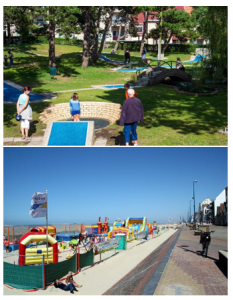
Pour ceux, qui ne s’intéressent pas tellement à l’histoire, il y a beaucoup d’autres divertissements pour tous les âges.
For those not so interested in history, there is plenty of other entertainment for all ages.
Et pour les amateurs de la nature, il y a une grande quantité de flore et faune à découvrir parmi les dunes et sur la plage qui se blottissent dans les dépressions creusées par le vent et la mer.
And for nature lovers, there is a wealth of flora and fauna to be discovered among the dunes and on the beach, which nestle in the depressions carved out by the wind and sea.
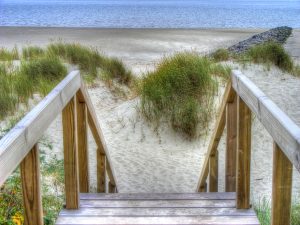
https://fr.wikipedia.org/wiki/Bray-Dunes#cite_note-13
https://fr.wikipedia.org/wiki/Dune_du_Perroquet
http://chemin.eklablog.net/dans-les-dunes-a-bray-dunes-a125243066
https://www.waymarking.com/waymarks/WMYRM6_Calvaire_des_marins_1953_Bray_Dunes_France
https://www.petitfute.co.uk/v26031-bray-dunes-59123/c1173-visites-points-d-interet/
Unst/Shetlands
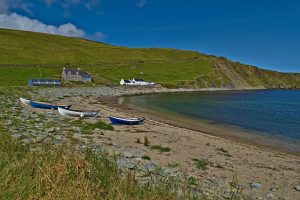
Having decided to start with the northernmost place in each country, in the UK, this took me all the way up to the Shetland Islands. This group of islands lies roughly 100 miles north-east off the Scottish coast, and the most northerly of them is called Unst. The origin of the name is hidden in the mists of time. It probably derives from some Old Norse word or even a pre-Norse language. One theory is that it comes from the Old Norse “Ornyst”, which means “eagle’s nest”.
Unst can lay claim to many “most northerly” places. The above picture shows the settlement of Skaw which is the northernmost settlement in the UK.
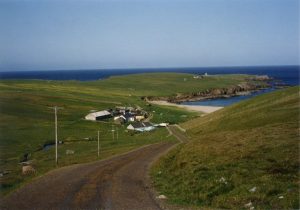

There, we can also find the northernmost house in the British Isles. It was once home to Walter Sutherland who died around 1850 and was reportedly the last native speaker of Norn, a North Germanic language which was once spoken throughout the Shetland and Orkney islands and also in the north-eastern corner of Scotland, in Caithness.
The most northerly lighthouse can be found on the tiny rocky island of Muckle Flugga (from Old Norse, “Mikla Flugey”, “large steep-sided island”) north of Unst. This used to be the northernmost inhabited island, but when the lighthouse was automated in 1995, the last residents moved away.
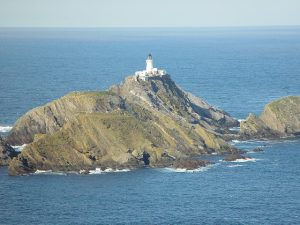
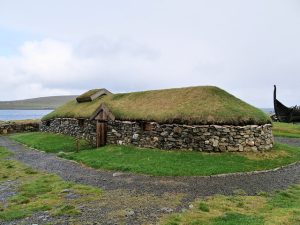
When the Vikings crossed the North Sea to look for new lands in the west, they landed and settled on the Shetland Islands as well We can therefore find lots of archaeological sites on Unst that date back to Viking times. Three of around 60 longhouses have been excavated as well as Viking burial grounds. In Haroldswick, the “Viking Unst Project” reconstructed one of these longhouses for the public to visit and learn about Viking settlements.
The other reconstructed Viking vestige is “The Skidbladner”, a full size, 24 meters long replica of a Viking ship that can be seen in Haroldswick as well.
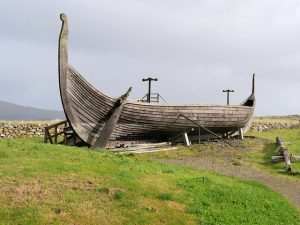
Another rather more unusual attraction of the island is “Bobby’s Bus Shelter”. More than 20 years ago, 6-year-old Bobby McCauley would wait for his school bus in an old, tumble-down bus shelter which was in such a state that the council decided to demolish it. Little Bobby, however, had a word to say about this and wrote to the local newspaper to ask for a new bus shelter, which was subsequently built. Shortly afterwards, different items started to appear mysteriously in the shelter: a sofa, a small wicker table, a carpet, a microwave. Whilst the first donations were anonymous, a proper team formed eventually and took it on to decorate the shelter with a different theme every year such as the Queen’s Golden Jubilee in 2002, Underwater, Africa, World Cup (2010) and the Diamond Jubilee (2012) to name but a few.

